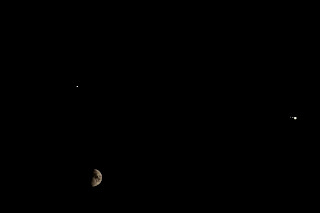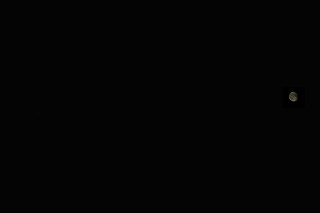September 27th 2020 GMT Moon and
Jupiter’s moons
Conditions were a bit hazy, despite a clear day. I had
trouble focussing on the Moon, with my settings on 300mm focal length, ISO 100
and 1/500 second exposure.
I used my usual settings for Jupiter’s moons: 300mm focal length, ISO 6400 and 2 seconds exposure.
September 25th 2040 GMT Lunar and Planetary Close-Ups
September 25th 2000 GMT Moon, Jupiter and Saturn
I had hoped to catch all three objects the evening before
but it was clouded out. If anything, the night of 25th, they were
closer, with the Moon particularly close to Saturn.
I started off with the Moon at 300mm focal length, ISO 100
and 1/400 second exposure.
I was not fully sure of the focal length but I fitted all three into the camera field of view at ISO 6400 and 1/50 second exposure.
I then took some frames of Jupiter at 300mm focal length,
ISO 6400 and 2 seconds exposure.
You can probably guess the next bit. Of course I superimposed Jupiter with its moons onto the original image.
September 24th 2300 GMT Mars
September 23rd 2015 GMT Meteor Hunt
I set a meteor trap aimed near the Summer Triangle. I had failed with a similar attempt the evening before and wanted another go, so set the focus carefully.
At 2025 GMT I caught a meteor travelling north west from Cygnus.
I also processed some frames as by-products to obtain yet another Cygnus/Lyra photo.
September 20th 2100 GMT Jupiter’s moons
September 20th 1820 GMT Moon
The thin crescent moon was low in the west. I took some frames with my DSLR at 300mm focal length, ISO 100 and 1/100 second exposure.
September 19th 2200 GMT Mars
Despite mowing 2 patches of dandelions, clover and moss the
day before, my back had recovered enough to use my largest telescope, my 127mm
Maksutov. My original intention was to look at Mars, which I had not since it
came into the evening sky. Mars is a difficult object at the best of times and
there was a clearish patch of sky above our house. Jupiter and Saturn were
obscured by clouds and, for much of the time, Mars was the only object visible
in the sky.
With it being a favourable opposition in October, the
martian disc was surprisingly large and showed a lot of albedo features across
its centre. This was despite using a magnification of 64x, quite low for Mars.
I swapped eyepieces to deliver a magnification of 103x. This made the detail
more clear and the polar ice cap flickered in and out of view. I added a Barlow
lens (2x) to produce a magnification of 206x. Many nights I had found this to
be the optimum but this night it resulted in a fuzzy image that was bouncing
around in the eyepiece.
I placed the original eyepiece back, in conjunction with the
Barlow lens, to produce a magnification of 128x. It was great! The albedo
feature seemed to have at least two branches and the ice cap was a clear
semicircle.
Although my primary intention was visual, I could not resist the temptation to photograph the planet through the eyepiece. The photo did not capture the ice cap but otherwise was a good representation of what I saw.
I also took some frames with my DSLR at 1.54 metres ISO 400 and 1/50 second exposure. I did not have time to increase the focal length before cloud rolled in. Unfortunately, I did not register an image,
I also caught a "guest star" in Perseus, not far from Alpha Persei. It may well also have been a meteor, as it was not visible on any surrounding frames.
At 2240 GMT, I caught a nice meteor, possible a member of a minor shower.
As usual, I processed some frames as by-products to obtain constellation shots. I stacked 20 early frames to catch Cassiopeia and some surrounding stars.I was also pleased to catch some deep sky objects, notably the Andromeda Galaxy (M31), Perseus Double Cluster and Melotte 20.
September 14th 0505 GMT Moon and Venus
The Moon and Venus fitted into the field of view of my DSLR
at 300mm focal length, ISO 100 and 1/200 second exposure.
September 12th 2115 GMT Meteors
September 11th 2230 GMT Deep Sky and Jupiter
September 10th 2120 GMT Jupiter’s moons
September 10th 0510 GMT Moon and Venus
It was dawn, so I took shots of the Moon, then Venus with my DSLR at 300mm focal length, ISO 100 and 1/320 second exposure.
September 6th 2140 GMT Moons
Conditions were somewhat hazy. I snapped Jupiter’s and
Saturn’s moons, or at least tried to.
I then snapped our moon at 300mm focal length, ISO 100 and
1/250 second exposure. Unfortunately, none of the shots produced a result that I could work with.
September 5th 2215 GMT
September 5th 2140 GMT Moon and Planets
I was still suffering from a bad hip, so did not take any telescopes outside. Instead, I took my camera out.
First up, I aimed at Jupiter and Saturn, in an attempt to capture their moons.
Next was the Moon and Mars.
Then the Moon on its own to capture some detail.
I had a final pot at Melotte 20. I don't normally do deep sky photography with a bright moon about but 11 frames stacked produced a better result than I would have expected.
September 4th 2250 GMT Moon
September 4th 2350 GMT Moon
After a couple of poor days and evenings, I saw a hint of
clear sky. Although there was some moving cloud, I snapped the Moon at 300mm
focal length and ISO 100. My initial setting of 1/400 second was too bright, so
I reduced it, in several steps to 1/640 second.
As Mars was around, I decided to snap Mars, just to see what I could get with a DSLR. As one does!
September 1st 2010 GMT Moon
It was dusk, with the Moon low and light cloud was
scattering its light. I used my DSLR at 300mm focal length, ISO 100 and 1/400
second exposure.
I then snapped Jupiter and Saturn together at ISO 6400 and 2
seconds exposure. I was not sure of the exact focal length but it was clear
that they were becoming closer in the sky.
As it was still twilight, I did not attempt to capture
Saturn’s moons but I had a go at Jupiter’s using my DSLR at 300mm focal length,
ISO 6400 and 2 seconds exposure. In retrospect, I should probably used a
shorter exposure.


































































